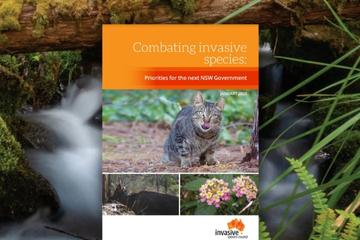The Senate is looking at how to better protect Australia from new invasive species. It has established an inquiry into the ‘adequacy of arrangements to prevent the entry and establishment of invasive species likely to harm Australia’s natural environment’.
This is your chance to be part of a ground-swell calling for change. Please make a submission to the inquiry and ask others to do so as well.
Why an inquiry?
The Australian environment already has a terrible burden of weeds, pests and diseases that have caused extinctions and massive declines in biodiversity. Despite this, new deadly invasive species keep arriving at a high rate.
These failures show that Australia’s biosecurity system is poorly prepared for new environmental invaders.
Serious environmental incursions detected since 2000 include:
- Myrtle rust: a deadly fungus first found in 2010 in a NSW plant nursery now infecting hundreds of Myrtaceae species (our dominant plant family), including several threatened species.
- Asian black-spined toad: found this year on Melbourne’s outskirts and likely, if it has established, to have similar impacts to the cane toad but with the capacity to inhabit cooler areas.
- Red imported fire ant: one of the world’s worst invasive species with an an intense sting that kills small mammals, birds and reptiles. A recent repeat incursion could have put at risk the $400m spent since 2001 trying to eradicate it.
- Mexican feather grass (Nassella tenuissima): a highly invasive ornamental grass that has the potential to dominate large areas of woodlands and grasslands. Despite it being illegal, it is still in gardens and easy to buy online.
- Smooth newt: found this year in Melbourne, it preys on and competes with native frogs, fish and other species. Its skin is toxic to predators.
- Pigeon paramyxovirus: a disease that arrived in Victoria three years ago that could infect a wide range of native bird species with a high rate of mortality.
Write a submission
Please write a submission to the Senate inquiry to call for stronger biosecurity to protect our precious natural environmental from yet more invasive species. Submissions are due 12 August. UPDATE: The committee secretariat informed us that if you request an extension via email ec.sen@aph.gov.au before 12 August, you can make a submission up to Fri 22 August.
If you have information on particular biosecurity weaknesses that have resulted or are likely to result in new invasive species please make a submission or pass the information onto the Invasive Species Council. (Note: submissions can be made to the inquiry in confidence.)
In your own words, make the following points in your submission, especially point 5. See our detailed submission guide for more information on these points:
- Highlight the importance of this inquiry to the future of Australian biodiversity. Preventing new invasive species should be one of the government’s highest environmental priorities. Issues:
- Devastating impacts of invasive species
- High rate of new incursions
- Environmental biosecurity lags that for agriculture.
- Note the high economic costs of failures to keep out environmental invaders. Issues:
- Puts existing eradication programs at risk
- Late detection wastes eradication funds
- Greatly increases costs to save threatened species and protect national parks
- Costs to industry, including tourism
- Note examples of incursions detected since 2000 that are likely to have serious impacts on the environment.
Examples: Myrtle rust, Asian black-spined toad, red-imported fire ant, Mexican feather grass, smooth newt, pigeon paramyxovirus, yellow crazy ant, electric ant, Asian honeybee
- Highlight the major systematic biosecurity gaps and flaws. Examples:
- Insufficient risk analysis
- Lack of contingency planning
- Insufficient surveillance
- Poor responses to incursions
- Failure to learn from failures
- Lack of transparency and reporting
- Support major recommendations to stop new invasive species that harm the environment:
- Establish Environment Health Australia, a collaborative body to prioritise risks, better prepare for environmental invaders and monitor progress
- Improve contingency planning
- Improve responses to incursions
- Improve surveillance
- Setup a public incursions database
- Review failures
- Improve enforcement
Send your submission to the Environment and Communications References Committee via email at ec.sen@aph.gov.au. Provide your name and contact details. Submissions are due 12 August 2014. UPDATE: The committee secretariat informed us that if you request an extension via email ec.sen@aph.gov.au before 12 August, you can make a submission up to Fri 22 August.
More info
Submission resources
- Full senate inquiry submission guide >>
- Our recent environmental biosecurity mistakes >>
- Environment Health Australia >>
- Integrating the environment into biosecurity >>



